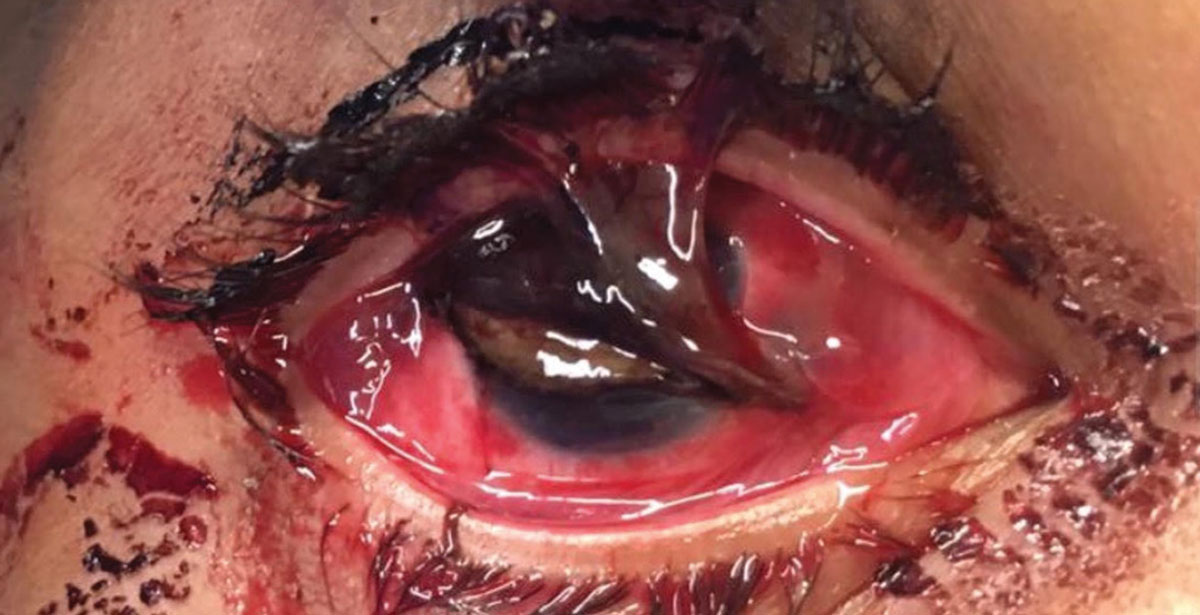 |
EMS protocols need to be more standardized so that cases of severe ocular trauma can be treated sooner and more effectively. Photo: Kristen Walton, OD. Click image to enlarge. |
Emergency medical services (EMS) are frequently the first responders to all types of incidents nationwide, providing the initial evaluation, management and stabilization for transport to definitive care. Comprehensive ocular emergency training for first responders may help reduce the likelihood of poor prognosis by identifying and stabilizing injuries closer to the incident time. However, a recent review of statewide EMS treatment protocols in the United States revealed that prehospital guidelines for management of ocular emergencies are inconsistent nationwide, with 50% of states with such protocols lacking designated ocular emergency sections.
The researchers received responses from 47 states, of which 30 had statewide EMS protocols. The team reviewed them for the presence of prehospital eye emergency guidelines and categorized information regarding the type of ocular emergencies addressed in each protocol and the recommended assessment and management guidelines.
A significant number of eye-related emergency department visits occur annually across the United States, most commonly in the South Census Region (36%), followed by the Midwest (24%), Northeast (23%) and West (17%) Census Regions. However, only half of the 30 US states with statewide EMS treatment protocols had a designated section for ocular emergencies, and only one of these included information regarding local specialty eye trauma centers.
Of the states with ocular emergency sections, the majority were in the Northeast (53%), followed by the South Census Region. Despite being responsible for approximately one-quarter of eye-related emergency visits in the United States, the Midwest Census Region had only one state with an EMS protocol that contained a designated section for ocular emergencies. None of the states in the West Census Region had a statewide EMS protocol containing an ocular emergency section.
Major ocular emergencies addressed in these guidelines included blunt trauma, penetrating trauma or puncture wounds, impaled objects, foreign bodies, chemical irritants, thermal or radiation burns and visual disturbances. While all states with an eye emergency section of their EMS statewide protocol included impaled objects, only one state addressed all seven of these topics.
Visual disturbances were included in less than half of the designated ocular emergency sections, despite being a possible indication of a stroke, which requires immediate medical attention. The researchers believed that this “could result in failure of prehospital personnel to assess for critical conditions in patients with visual complaints.”
For the 15 states lacking a designated ocular emergency section in their statewide EMS protocol, 13 included some reference to visual disturbances and chemical irritants affecting the eye in alternative sections of their protocol. None addressed ocular foreign bodies or impaled objects.
“Even among those states with ocular emergency guidelines, significant discrepancies exist regarding the types of eye emergencies included in each protocol, with many states failing to include common or high acuity eye emergencies requiring immediate medical attention,” the researchers concluded in their paper. “Clinicians should work with local, state and national partners to develop and implement a national model EMS protocol for ocular emergencies in order to standardize and optimize prehospital eye care.”
Gardin MA, Wolf BJ, Kahn PA. Nationwide emergency medical services guidelines for care of ocular emergencies. Ophthalmology. July 13, 2022. [Epub ahead of print]. |


